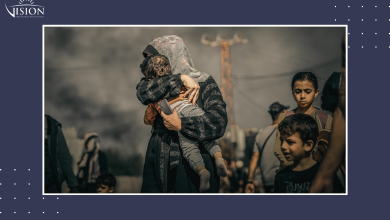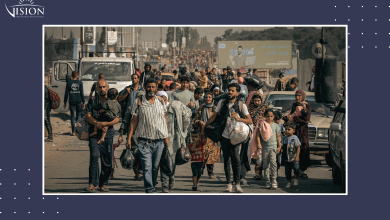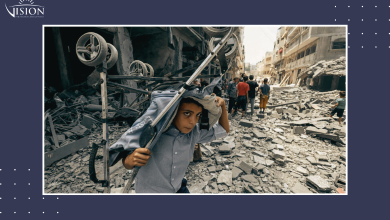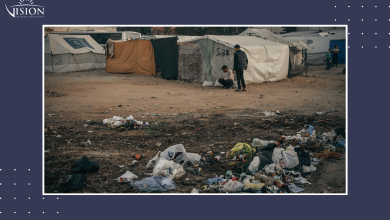Masafer Yatta: Israeli-Backed Settlement Expansion and Abandonment of Palestinian Resilience
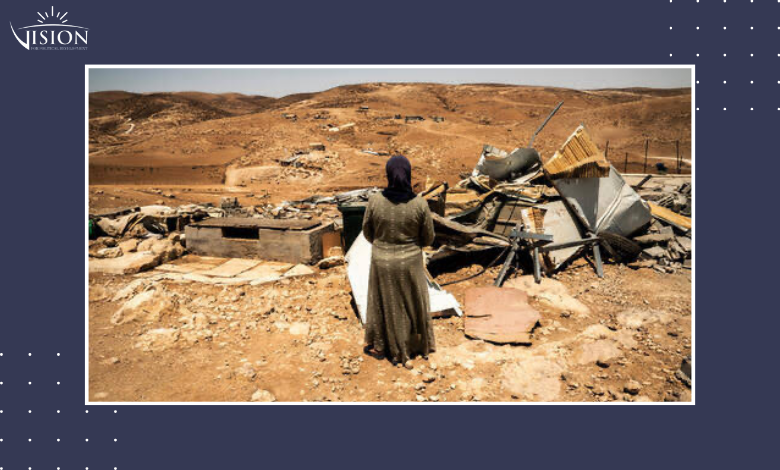
Since October 7, 2023, the Masafer Yatta area, southeast of Hebron, has faced an intensified Israeli campaign of forcible transfer, an act explicitly prohibited under international humanitarian law. This campaign has unfolded through the creation of new settler outposts, their consolidation into existing settlement blocs, and a surge in settler violence directed against the area’s 4,000 Palestinian residents. Violence has escalated to the point of direct firing on civilians, such as the killing of Odeh al-Hathaleen from the village of Umm al-Kheir, who was shot dead by an Israeli settler on July 29, 2025. Simultaneously, Israeli authorities have accelerated demolition and eviction orders, effectively weaponizing law and bureaucracy to uproot Palestinian families from their ancestral lands.
This paper examines the strategic significance of Masafer Yatta and the objectives Israel seeks to achieve through these policies of dispossession, executed through settler violence, shielded by the military, and fuelled by vast state resources. Taken together, these measures amount to a systematic campaign of ethnic cleansing. Meanwhile, Palestinian residents are left abandoned to resist alone, with collapsing health, relief, and education services incapable of meeting even the most basic human needs.
The Historical Context of Settlement in Masafer Yatta
Israel views Masafer Yatta as a crucial geographic and historical link between the Bedouin communities of the Hebron Hills (territories occupied in 1967) and the Nagev Desert (territories seized in 1948). From this perspective, severing that connection and replacing it with Jewish settlers became a strategic imperative. This vision was central to Ariel Sharon’s settlement plans when he served as Minister of Agriculture in Menachem Begin’s first government.
In a meeting of the Ministerial Committee on Settlement on November 20, 1979, Sharon stated:
“For several years now there has been an ongoing phenomenon, the material connection between the Arab population of the Negev and the Arabs of the Hebron Hills. A situation has developed in which borders are being entrenched within our land… We must quickly establish a buffer strip of settlements, which will separate and distinguish the Hebron Hills from the Jewish settlements in the Negev.”
As a result, Israeli authorities classified Masafer Yatta as a strategic military zone and designated it as a prime site for settlement expansion in the West Bank. This coincided with the broader colonial project across the West Bank, particularly in the areas classified as “Area C” under the 1994 Taba Agreement between the Palestinian Authority and Israel. The underlying goal was to depopulate the remaining Palestinian communities in these regions, especially Bedouin encampments, which for decades have posed the most formidable obstacle to Israel’s expansionist ambitions, despite their small numbers and lack of resources,.
For decades, Masafer Yatta has been subjected to systematic attempts by the Israeli state and settlers to uproot its indigenous inhabitants under the guise of “security concerns” or the false designation of land as “firing zones” or “reserves for future settlements.” Today, the area encompasses approximately 19 Palestinian Bedouin and agricultural communities scattered across semi-arid hills and valleys of the region. To sever Masafer Yatta from the wider Palestinian body, Israel developed a settlement strategy designed to normalize gradual expulsion until full depopulation could be achieved.
A fact sheet by OCHA highlights that, since the 1980s, most of Masafer Yatta was declared as “Firing Zone 918.” Since then, these Palestinian communities have been subjected to a series of Israeli policies and practices that have steadily dismantled the foundations of their existence and undermined their livelihoods, including restrictions on movement, construction bans, repeated demolitions, and ongoing settler attacks.
Over the years, the Israeli occupation authorities have issued a succession of orders laying the groundwork for settler control of “the Masafer,” while simultaneously suffocating Palestinian population by prohibiting their construction, movement, and the development of livelihoods.
Although Israel claims these lands are reserved for military training and therefore off-limits to civilian population, it not only allows but even facilitates the presence of Israeli settlers. This stark double standard exposes the hollowness of Israel’s legal justifications and the manipulation of “military training” as a tool for Palestinian displacement. On this basis, settlers began establishing outposts in Masafer Yatta from 2001 onwards. The first, Avigail, became the nucleus of settlement expansion in the area. It was established inside the so-called “military firing zone” and dozens of settler housing units were erected despite at least 17 demolition orders issued by Israeli courts, none of which were enforced.
In the years that followed, Israeli authorities authorized the establishment of several major settlements on the lands of eastern Yatta and Masafer Yatta, including: Carmel, Ma’on, Mitzpe Yair, Metzadot Yehuda, Susiya, and Avigail. Collectively, these settlements form a tightening noose around the Palestinian communities, exacerbating the threat of forcible transfer and cementing a regime of permanent dispossession.
The Escalation of Israeli Settlement in Masafer Yatta (2023–2024)
The pace of Israeli settlement in Masafer Yatta continued to accelerate, reaching a notable surge in 2023 and 2024, when several new settlements and outposts were established alongside large-scale infrastructure development.
In 2023, the settlement of Har Eila was established, connected by a new road to the outpost of Mitzpe Yair. The settlement includes several buildings and solar panels. That same year, the settlement of Dromah was founded, linked by a road to the Avigail outpost and connected to its shared water network. Another settlement, Tov Ha’aretz, was created, consisting of a single family residence, a goat pen, and agricultural structures. In addition, Har Ma’on was established, comprising residential and agricultural buildings, solar panels, and surveillance posts set up in its surroundings that function as monitoring and control points.
In 2024, the outpost of Mitzpe Yair North was erected between the houses of the Palestinian village of Simri, whose residents had earlier been expelled following repeated settler assaults and threats. That same year, the Naveh outpost was established as an extension of a neighbourhood attached to Avigail, containing several buildings, an electric gate, and solar panels.
According to the Israeli organization Peace Now, the settlement of Mitzpe Malkiya was set up on the site of a former military observation post, supplied with solar panels and connected to a water pipeline, reflecting direct logistical support to consolidate the settler presence.
Colonial Law Serving Expulsion and Displacement
For decades, residents of Masafer Yatta have faced a continuous stream of demolition orders and eviction notices. The first of these dates back to 1999, when Israeli authorities issued a decision to expel nearly 700 Palestinians on the pretext that they were living “illegally” in a closed military firing zone. At the time, the order was accompanied by demolitions of homes and shops and the confiscation of essential property.
Since then, dozens of such orders and warnings have been issued, while numerous legal petitions, mostly submitted by non-governmental human rights organizations, sought to halt the forced displacement. Yet the asymmetrical legal struggle consistently favoured the settlement enterprise.
In May 2022, Israel’s High Court of Justice gave a ruling in favour of expelling hundreds of Palestinian residents of Masafer Yatta, paving the way for the transfer of their lands to exclusive Israeli use. The ruling was described as one “tailor-made to serve settlement expansion.”
Following the decision, the Israeli army was officially authorized to begin using the area for live-fire military training. Tanks rolled through villages, live ammunition was fired, and explosives were detonated, while helicopters practiced landing and take-off in the vicinity of residential clusters. The suffering of residents was further compounded by the use of drones operated by Israeli soldiers and at times even settlers, to monitor whether Palestinians attempted to rebuild their demolished homes.
Accelerating Settlement and Escalating Violence
In recent years, Masafer Yatta has witnessed a sharp turning point in the pace of settlement expansion, marked by what can only be described as an unprecedented “settlement surge” in both speed and intensity. This is confirmed by the testimonies of local residents: since early 2023, the region has faced a sustained and severe escalation of settler assaults, resulting in Palestinian casualties as well as grave damage to property and livelihoods.
Shawq al-‘Adra, a resident of al-Jawaya village, explains:
“Over the past ten years, the settlements have expanded rapidly. From the roof of our house, I can see them surrounding us from almost every direction. With the growing number of settlers, the violence has escalated too. We face constant harassment while grazing sheep or harvesting crops. The attacks have become more frequent, and more deadly—in terrifying ways.”
This is echoed in the testimony of Hanadi al-Hathalin, the wife of Odeh al-Hathalin, who was killed by settler gunfire in the area. Days after his killing, the settler responsible was briefly detained, only to be released shortly thereafter, an outcome that underscores the entrenched impunity settlers enjoy, which in turn emboldens further violence, even to the point of lethal attacks. These testimonies document a shift from what was once a “silent occupation” into an active, aggressive settler reality, coupled with a daily system of field-level violence that exposes the existential threat now confronting the residents of Masafer Yatta.
While the violence surged further after October 7, 2023, this escalation was neither sudden nor isolated. Rather, it represents a continuation of a long-standing trajectory, whereby settlers seize upon every circumstance or political event to advance their settlement projects, all under the protection of systematic impunity.
A historical comparison of settler attacks in Masafer Yatta reveals a shocking escalation. Between 2006 and 2020, just 18 incidents were documented. By contrast, 180 attacks were recorded between 2021 and 2024, reflecting a structural transformation of settler violence, from sporadic occurrences into a systematic field policy, according to a report by OCHA. The UN agency’s data highlights the acceleration: the monthly average of attacks rose from 1.5 incidents in 2021–2022 to nearly five incidents per month during 2023–2024. This upward trajectory continued into 2025, with OCHA documenting approximately six incidents per month in the first quarter alone.
The forms of these attacks vary: direct physical assault including beatings with sticks, stone-throwing, terrorizing livestock by driving horses or all-terrain vehicles through herds, unleashing trained dogs on shepherds and their flocks, in addition to arson of farmland and uprooting of trees.
Simultaneous with this violence, and as part of advancing settlement and displacement goals, especially in the aftermath of the war, demolitions intensified. According to the reports of the Palestinian Wall and Settlement Resistance Authority for 2023 and 2024, Hebron, including Masafer Yatta, was classified as the most targeted area in Palestine for demolition orders during those years, under the pretext of “combating illegal construction.” Meanwhile, illegal settler outposts were left untouched, with demolition orders against them left unenforced.
State-Supported Settlement Advances… While Palestinian Resilience is Left Without Means
Amid escalating violence, settlement expansion, and the demolition of Palestinian homes and structures, steps paving the way for the actual displacement of residents; the people of Masafer Yatta face an urgent need for an official and popular strategy to resist. Yet the grim reality stands in stark contradiction to the scale of the threat facing the area and its inhabitants.
While Israel increased its settlement support budget for 2023 by 320%, mobilizing all resources and legislative measures to advance its colonial enterprise, it simultaneously imposed a regime of deliberate stagnation on the Palestinian community of Masafer Yatta, effectively freezing it in time and obstructing all avenues for its progress and development.
In consequence, the area lacks the bare minimum of basic necessities: residents live in harsh, primitive conditions such as tents, tin shacks, or caves dug into the rock, all devoid of electricity, sewage systems, communications, and critical infrastructure. This is not geographic isolation but an imposed segregation, engineered by Israeli racist apartheid policies.
According to the South Hebron Hills report by B’Tselem, the absence of water, electricity, infrastructure, and construction in Masafer Yatta results from Israeli occupation’s deliberate decisions to make life impossible for residents. Authorities prevent the establishment of power grids, destroy alternative solar energy systems, demolish rainwater cisterns, and block building permits under the pretext of lacking a zoning plan; measures designed to render the area uninhabitable for Palestinians.
Meanwhile, Palestinian residents are left alone to face settler brutality. No Palestinian government health centers operate in the area. Even though residents are nominally entitled to state health insurance, no facilities exist to provide life-saving care. Reaching clinics outside the area is difficult due to Israeli restrictions. As Médecins Sans Frontières (MSF) noted in its report, Palestinians in Masafer Yatta live under deteriorating health conditions caused directly by settler and military violence.
Children in Masafer Yatta also suffer from interrupted, unequal, and at times completely absent education. Despite the Ministry of Education’s efforts since 2016 to establish ten “Schools of Resilience and Challenge,” Israel has demolished three in recent years: Khallet al-Daba’, Imreha, and Safi. Existing schools remain under demolition threats and are poorly equipped. The absence of secondary education forces students either to halt their schooling at the elementary level or to risk dangerous commutes outside the area, exposed to constant settler violence.
For instance, in Khirbet al-Daba’, home to 74 Palestinians across 14 families, there is neither a health clinic nor a school, as the only one that once stood was demolished by Israel.
At the same time, since October 7, 2023, settlement herding outposts have expanded significantly, with 20 new ranching outposts established in Masafer Yatta and more than 25 across the South Hebron Hills. Settlers armed and protected by Israeli forces graze thousands of stolen animals. Their activities have led to environmental degradation, desertification, and weakened land protection, deliberately undermining Palestinian livelihoods.
This escalation has had devastating socioeconomic effects. Two years ago, residents collectively owned about 24,000 head of livestock, their primary source of income. By this year, the number dropped to fewer than 8,000. Settlers are accused of mass theft of livestock, deliberate shootings, and poisoning. In contrast, settlers now control pastoral settlements with herds of over 4,000 sheep, cattle, and camels, many stolen from Palestinians.
In the face of these pressures, the Palestinian Authority’s approach has been reduced to rhetoric. Under the slogan of “supporting citizens’ steadfastness,” officials praise the so-called “legendary resilience” of residents during visits to the area. Yet beyond symbolic visits and statements, little has changed.
On education, for instance, Palestinian authorities have issued repeated statements appealing to the international community to protect children in Masafer Yatta, but these declarations and condemnations have done little in terms of practically helping students whose schools have already been demolished or remain under threat of demolition.
Support on the ground has amounted to tents, tractors, and occasional aid packages, all insufficient measures that frame Palestinians as refugees in their own land rather than rightful inhabitants. Official visits are rare and largely confined to symbolic occasions, and the surge of violence post-October 2023 has not triggered any meaningful policy upgrades in dealing with this humanitarian catastrophe.
Even the interventions announced in 2022 during Prime Minister Mohammad Shtayyeh’s “Steadfastness and Challenge” conference remain largely unimplemented. Unemployment remains high, and livelihoods continue to deteriorate, as pointed out by Nidal Younis, head of the Masafer Yatta village council, in a press interview.
Meanwhile, Palestinian officialdom continues to rely on international appeals, sending letters to the EU and international bodies to prevent displacement. But beyond condemnations and symbolic statements, no effective lawsuits or challenges have been mounted against the Israeli Supreme Court’s ruling that permits expulsion.
Conclusion
The people of Masafer Yatta are enduring the harshest chapter of their lives, with even greater challenges looming ahead. Empty slogans about resilience, hollow government promises, and ritual visits provide no relief. Internal Palestinian solidarity is absent, and factional mobilization nonexistent.
All this comes as Israel pours massive budgets into settlement expansion, while Palestinians are stripped of even the most basic rights. Left isolated, they stand on the brink of imminent forced displacement.
To summarize, it is worth recalling the words of journalist Ramzy Baroud, editor of The Palestine Chronicle:
“What is happening in Masafer Yatta is not only the largest ethnic cleansing project carried out by Israel since 1967, but it must also be understood as the first stage of a much larger plan of illegal land seizure, ethnic cleansing, and mass annexation. Israel must not be allowed to succeed in Masafer Yatta, because if it does, its original blueprint for large-scale annexation will soon become a reality.”
NOTE: This text is adabted from original Arabic article.


